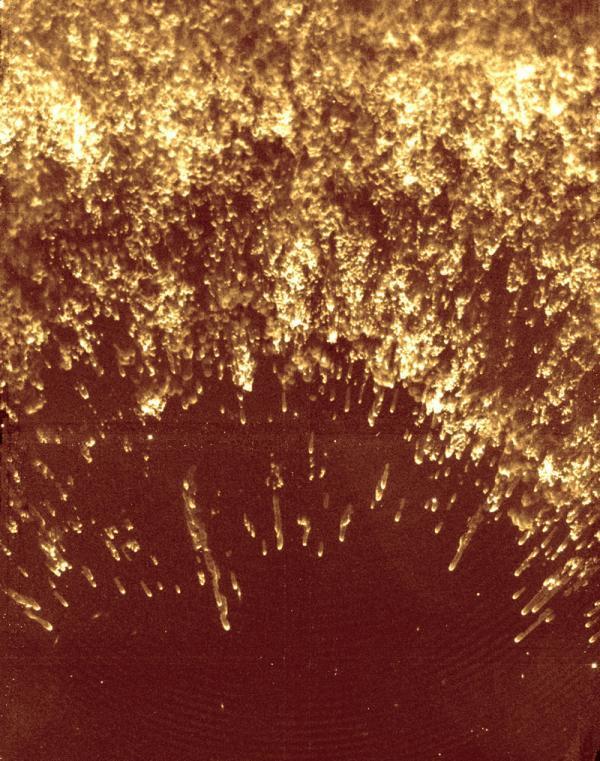Performing fireworks in the Helix Nebula
The Helix Nebula, NGC 7293, is not only one of the most beautiful and captivating planetary nebulae; it is also the closest nebula to the Earth, with a 710 light-year distance. A new photo, taken with an infrared camera on the Subaru Telescope in Hawaii, shows tens of thousands of knots shaped like comets inside this nebula that had never been known before. They look like a giant fireworks show in space.
The Helix Nebula is the first planetary nebula in which comets shaped like comets are observed, and the presence of these knots can provide clues to planetary materials that survive in the end of a star's life. Planetary nebulae are the final state in the life cycle of light mass stars, such as our Sun. At the end of life, they release a large amount of material into space. Although the nebula looks like a fireworks display, the process of forming a nebula does not include spectacular explosions that happen immediately. The nebula is slowly formed over a period of 10,000 to 1,000,000 years. This process creates the nebula by 'exposing' the inner nucleus, where nuclear reactions have occurred, and since then ultraviolet radiation illuminates the released materials.
 The near-infrared image of the Helix Nebula shows the comets shaped like comets. They look like a giant fireworks show in space. (Photo: Subaru Telescope, NAOJ)
The near-infrared image of the Helix Nebula shows the comets shaped like comets. They look like a giant fireworks show in space. (Photo: Subaru Telescope, NAOJ)
Astronomers from the Japanese National Observatory (NAOJ), from London, Manchester and Kent universities in the United Kingdom, and from a university in Missouri, USA studied the release of hydrogen molecules in Infrared light and detection of knots in the entire nebula . Although these molecules are often destroyed by ultraviolet radiation in space, they still survive in these knots, protected by dust and gas that can be seen with optical images. The comet-like form of these knots is the result of evaporation from knots, due to strong winds and ultraviolet radiation from the dying star that forms in the center of the nebula.
Unlike gout optical images of the Helix Nebula, the infrared image shows thousands of clearly resolved knots, extending from the central star to a greater distance than previously observed. The range of comet tails depends on the distance from the central star, as the solar system's comet has larger tails when they are closer to the Sun and when the wind and radiation are stronger. Dr Mikako Matsuura, a former student of NAOK and currently working at the University of London, said: 'This study shows how the central star can slowly destroy the knots and state the positions. that molecular and atomic materials can be found in space '.
These photos allow astronomers to estimate about 40,000 knots in the entire nebula, each of which is billions of kilometers per mile.Their total mass may be 30,000 times the Earth, or 1/10 of the Sun's mass. The origin of these knots is still unknown. Are they the rest of a star's planetary system, or the material released from a star in a certain period of life? Any answer will help astronomers solve questions about star systems and planets.
The advanced technology of the Subaru Telescope with its near-infrared camera, MOIRCS, has allowed researchers to create impressive images. Located on one of the world's largest infrared optical telescopes, MOIRCS (Multi-Object Camera and Spectrophotometer) has a wide view, allowing it to capture images with resolution and detail. high.
The study will be published in the August 2009 Astrophysical Journal.
- The eye of the Helix Nebula
- The magical beauty of the 'eyes of God'
- The nebula is like a giant crimson eye in the universe
- Beautiful photo: Physical dust and gas surrounding the Helix nebula
- Admire the beautiful array of astronomical images celebrating Hubble's 25 years old
- 'God's eyes' in the universe
- Beautiful sight of a dying star
- The birth history of fireworks
- Let's see the structure of each firework
- The most beautiful cosmic photos in 25 years
- The incalculable harm of fireworks
- See the most beautiful astronomical photos on display in London
 Van Allen's belt and evidence that the Apollo 11 mission to the Moon was myth
Van Allen's belt and evidence that the Apollo 11 mission to the Moon was myth The levels of civilization in the universe (Kardashev scale)
The levels of civilization in the universe (Kardashev scale) Today Mars, the sun and the Earth are aligned
Today Mars, the sun and the Earth are aligned The Amazon owner announced a secret plan to build a space base for thousands of people
The Amazon owner announced a secret plan to build a space base for thousands of people